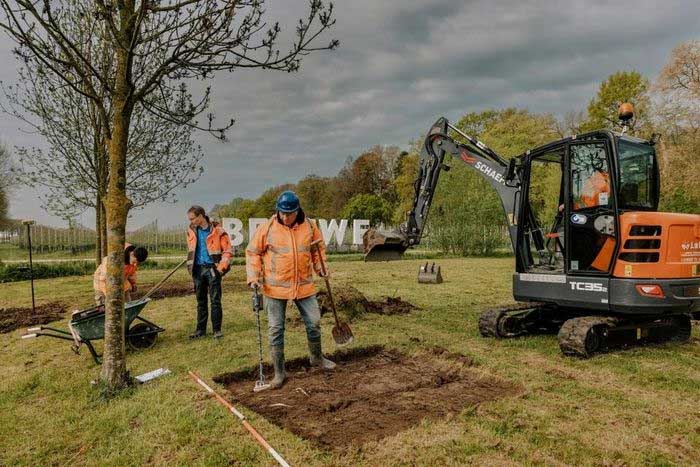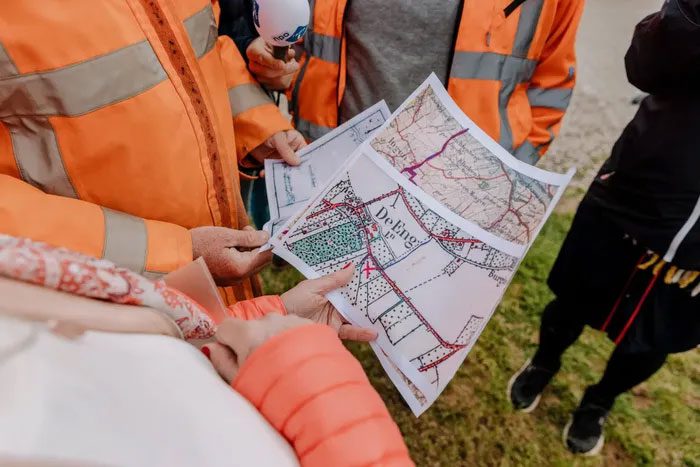A map sketched by Nazi soldiers has sparked a modern treasure hunt in a small village in the Netherlands. However, the treasure remains a mystery to this day.
After months of waiting for approval from local Dutch authorities and favorable weather conditions, the moment finally arrived. On the morning of May 1st, a team of experts began excavating the treasure buried by the Nazis in the town of Ommeren.

A team of experts and archaeologists in the village of Ommeren, Netherlands, on May 1. (Photo: New York Times).
Ms. Joke Honders, a local historian who has lived here for many years, is leading this complex operation, which involves metal detectors, excavators, and a group of archaeologists. She cannot help but be amazed by what is unfolding before her eyes.
“It’s fascinating,” she said. Ms. Honders coordinated the real-life treasure hunt on a grassy area next to an apple orchard in Ommeren, a dull village with about 750 residents located 65 km southeast of Amsterdam.
No Results
Despite digging three separate holes in the area that Ms. Honders marked using a combination of ancient maps, modern maps, and a hand-drawn map by a Nazi soldier, the search team found nothing.
That morning also marked the end of a months-long treasure hunt. During that time, dozens of people came equipped with shovels and metal detectors to this tiny Dutch village in hopes of unearthing four boxes filled with jewelry, gold, and stolen watches.
“The modern gold rush” began in January when thousands of documents were declassified by the Dutch National Archive, revealing the existence of a map drawn by Nazi soldiers in 1945. The map is believed to mark the location of a real treasure.
The hand-drawn map with a red X has ignited a modern treasure hunt in this small village in the Netherlands, AP reported. The treasure contains many items looted by Nazi soldiers following a bank vault explosion in 1944.
Weeks before the end of the war, five Nazi soldiers buried that treasure. Helmut Sonder, another soldier, lay watching his comrades as he was injured.

The map drawn by a Nazi soldier spurred the treasure hunt in the Netherlands. (Photo: New York Times).
According to documents, Sonder relied on memory to sketch the map, perhaps intending to return for the spoils. This very map triggered the hunt for gold and jewelry and elevated Ommeren’s fame.
The map indicated that the treasure was buried about 0.5-0.7 meters deep, next to three poplar trees. However, those trees have long since disappeared, leaving the exact location a mystery.
The search led by Ms. Honders was the only effort permitted by authorities to find what was buried. The city of Buren, which includes Ommeren, declined several similar requests, according to Pieter Neven, a city official.
He explained that Ms. Honders’ proposal was approved because they wanted the search to be conducted professionally. According to Mr. Neven, the city funded Ms. Honders’ search with approximately $2,200 to help cover the costs for archaeologists and professional metal detector operators.
“Searching for a needle in a haystack”
On the morning of May 1st, Ms. Honders and many others on the search team did not have high expectations. “It’s like searching for a needle in a haystack,” said Jan van Renswoude, an archaeologist involved in the treasure hunt.
As the prospects of success dwindled, Ms. Honders asserted: “I still have hope.”
However, the lack of treasure was not surprising. “I didn’t expect anything,” said Arie Krijgsman, who has lived in Ommeren for 15 years.
He expressed his fascination with the search. “It’s a bit like a gold rush,” he added.

An expert using a metal detector at the site. (Photo: New York Times).
No treasure was uncovered, but archaeologists did excavate a 9mm bullet from World War II, some scrap metal, and iron wire.
Klaas Tammes, former mayor of Ommeren, stated that the treasure remains a mystery. Previously, this village had witnessed various archaeological activities. In 2016, three treasure hunters found a cache of 31 gold Roman coins.
However, experts agree that the chance of finding the Nazi treasure is very slim, and it may have been dug up decades ago.
After about four hours of searching and digging, the archaeologists turned off the excavators, concluding this effort. According to Mr. Neven, this will be the last time the city approves a request to search for the Nazi treasure, although it is unclear whether amateur treasure hunters will be discouraged.
NBC reported in January that despite the slim chances of finding valuable items, that has not deterred amateur gold diggers. “I see groups of people with metal detectors everywhere,” said Jan Henzen, 57, to Reuters.
Even though only a few items of little value were recovered, Ms. Honders seemed content with the results.
“I was able to sleep soundly tonight,” Ms. Honders shared.


















































